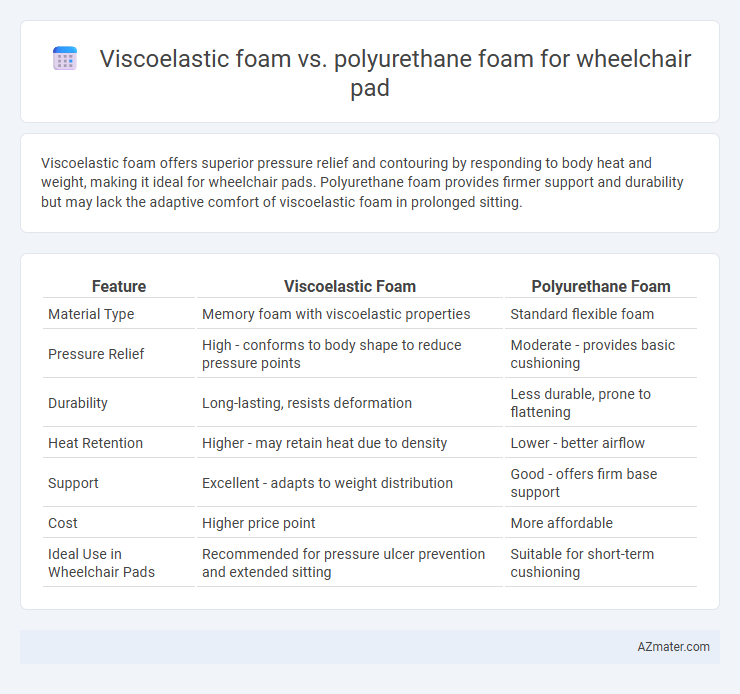Viscoelastic foam offers superior pressure relief and contouring by responding to body heat and weight, making it ideal for wheelchair pads. Polyurethane foam provides firmer support and durability but may lack the adaptive comfort of viscoelastic foam in prolonged sitting.
Table of Comparison
| Feature | Viscoelastic Foam | Polyurethane Foam |
|---|---|---|
| Material Type | Memory foam with viscoelastic properties | Standard flexible foam |
| Pressure Relief | High - conforms to body shape to reduce pressure points | Moderate - provides basic cushioning |
| Durability | Long-lasting, resists deformation | Less durable, prone to flattening |
| Heat Retention | Higher - may retain heat due to density | Lower - better airflow |
| Support | Excellent - adapts to weight distribution | Good - offers firm base support |
| Cost | Higher price point | More affordable |
| Ideal Use in Wheelchair Pads | Recommended for pressure ulcer prevention and extended sitting | Suitable for short-term cushioning |
Introduction to Wheelchair Padding Materials
Viscoelastic foam, also known as memory foam, offers superior pressure relief and contouring by responding to body heat and weight, making it ideal for preventing pressure sores in wheelchair users. Polyurethane foam provides a more economical and lightweight option with varying densities, but it may compress faster under prolonged use, reducing its cushioning effectiveness. Selecting the right wheelchair pad material involves balancing comfort, durability, and support to enhance user mobility and reduce the risk of skin breakdown.
What is Viscoelastic Foam?
Viscoelastic foam, commonly known as memory foam, is a material characterized by its ability to conform to the body's shape while providing pressure relief and optimal support for wheelchair pads. Unlike regular polyurethane foam, viscoelastic foam responds slowly to pressure, enhancing comfort by redistributing weight and minimizing pressure points to reduce the risk of pressure sores. Its unique properties make it especially suitable for wheelchair cushions where prolonged sitting requires both cushioning and pressure management.
What is Polyurethane Foam?
Polyurethane foam is a versatile, synthetic material widely used in wheelchair pads for its lightweight and cost-effective cushioning properties. It offers moderate support and pressure distribution, making it suitable for short to medium durations of wheelchair use. Compared to viscoelastic foam, polyurethane foam typically provides less contouring and rebounds faster, which may affect comfort for long-term pressure relief.
Comfort and Pressure Relief Comparison
Viscoelastic foam, also known as memory foam, offers superior pressure relief for wheelchair pads by evenly distributing body weight and conforming closely to the user's shape, reducing pressure points and enhancing comfort during prolonged sitting. Polyurethane foam provides firmer support with quicker rebound but lacks the same adaptive cushioning properties, potentially leading to increased pressure and discomfort over time. Choosing viscoelastic foam improves comfort and reduces the risk of pressure ulcers compared to standard polyurethane foam in wheelchair seating applications.
Durability and Longevity Differences
Viscoelastic foam offers superior durability due to its ability to retain shape and resist breakdown under continuous pressure, making it ideal for wheelchair pads that require long-term support. Polyurethane foam, while initially softer, tends to degrade faster with repeated use, leading to compression and loss of cushioning over time. The longevity of viscoelastic foam ensures sustained comfort and pressure relief, whereas polyurethane foam typically requires more frequent replacement.
Temperature Sensitivity and Breathability
Viscoelastic foam for wheelchair pads exhibits high temperature sensitivity, softening with body heat to provide superior pressure relief but potentially causing heat retention. Polyurethane foam maintains consistent firmness regardless of temperature, offering better structural support but less contouring comfort. Breathability in polyurethane foam is generally higher due to its open-cell structure, while viscoelastic foam's denser composition can reduce airflow, increasing heat accumulation.
Support and Body Conformance
Viscoelastic foam offers superior body conformance by contouring closely to the user's weight and shape, providing enhanced pressure distribution and minimizing pressure points for wheelchair pad users. Polyurethane foam delivers firmer support with quicker response but may lack the adaptive molding properties, resulting in less effective pressure relief and comfort over extended periods. Choosing viscoelastic foam for wheelchair pads improves support tailored to individual body contours, reducing discomfort and risk of pressure ulcers compared to traditional polyurethane options.
Maintenance and Cleaning Considerations
Viscoelastic foam wheelchair pads require gentle cleaning with mild soap and water, avoiding harsh chemicals to maintain their memory foam properties, while polyurethane foam pads are generally more resistant to moisture and can withstand more frequent cleaning with standard household cleaners. Both foams should be air-dried thoroughly to prevent mold and mildew growth, but viscoelastic foam is more prone to retaining moisture and odor if not properly dried. Regular maintenance of polyurethane foam pads often involves simple wiping, making them a more durable option for users seeking low-maintenance wheelchair cushioning.
Cost Comparison: Viscoelastic vs Polyurethane
Viscoelastic foam wheelchair pads typically cost 20% to 50% more than polyurethane foam due to their advanced pressure-relief properties and durability. Polyurethane foam offers a lower initial investment but may require more frequent replacement, potentially increasing long-term expenses. The cost difference reflects variances in material density, lifespan, and comfort level essential for pressure management in wheelchair users.
Choosing the Right Foam for Wheelchair Users
Viscoelastic foam offers superior pressure relief and contouring, ideal for wheelchair users requiring enhanced comfort and skin protection during extended seating periods. Polyurethane foam provides greater durability and firmer support, suitable for users needing stability and cost-effective cushioning. Selecting the right foam depends on individual needs for pressure distribution, mobility, and budget to ensure optimal seating comfort and injury prevention.

Infographic: Viscoelastic foam vs Polyurethane foam for Wheelchair pad
 azmater.com
azmater.com